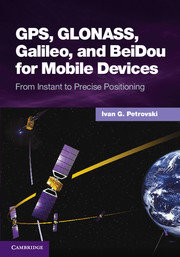Book contents
- Frontmatter
- Contents
- Foreword by Glen Gibbons
- About this book
- Acknowledgments
- List of abbreviations and acronyms
- List of definitions
- Part I GNSS: orbits, signals, and methods
- Part II From conventional to software GNSS receivers and back
- 5 Generic GNSS receivers
- 6 Receiver implementation on a general processor
- 7 Common approach and common components
- Part III Mobile positioning at present and in the future
- Part IV Testing mobile devices
- Index
- References
5 - Generic GNSS receivers
from Part II - From conventional to software GNSS receivers and back
Published online by Cambridge University Press: 05 May 2014
- Frontmatter
- Contents
- Foreword by Glen Gibbons
- About this book
- Acknowledgments
- List of abbreviations and acronyms
- List of definitions
- Part I GNSS: orbits, signals, and methods
- Part II From conventional to software GNSS receivers and back
- 5 Generic GNSS receivers
- 6 Receiver implementation on a general processor
- 7 Common approach and common components
- Part III Mobile positioning at present and in the future
- Part IV Testing mobile devices
- Index
- References
Summary
Digest of GNSS receiver operation
A GNSS receiver estimates position by measuring distances to a few satellites. When it measures the distance to the satellite, it in fact measures a signal propagation time from the satellite to the antenna. The satellite signal bears a time mark, which indicates when the signal was transmitted.
First, we look at the GPS L1 C/A signal. The signal can be considered to consist of three layers, namely the carrier layer, the code layer, and the navigation data layer (see Figure 5.1). These three layers have different time resolutions. Other signals may have additional layers. The GLONASS L1 SP signal, for example, has an additional meander sequence. Galileo, BeiDou, modernized GPS, and GLONASS have additional code layers. The length of the navigation message bit for the GPS L1 C/A signal is 20 ms. One can multiply this time interval by the speed of light to calculate the length of the navigation bit. For a GPS L1 C/A signal, the code sequence has 1023 bits, and this repeats itself each millisecond. For mobile devices, we are mostly interested in code positioning only. The 1 ms time is approximately equal to 300 km. The length of one code chip is therefore 300 km divided by 1023 code chips, i.e. about 300 m. In order to achieve positioning accuracy of a few meters, a receiver must be able to measure the code phase with an accuracy of one-hundredth of a code bit. A receiver can measure a code phase by aligning the incoming signal from a satellite with an internal code replica.
- Type
- Chapter
- Information
- GPS, GLONASS, Galileo, and BeiDou for Mobile DevicesFrom Instant to Precise Positioning, pp. 131 - 168Publisher: Cambridge University PressPrint publication year: 2014



